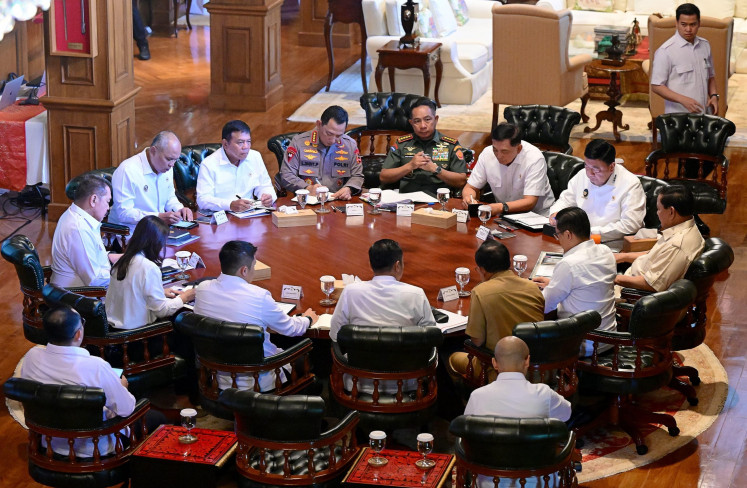Popular Reads
Top Results
Can't find what you're looking for?
View all search resultsPopular Reads
Top Results
Can't find what you're looking for?
View all search resultsSouth Tangerang to build waste-to-energy plant
South Tangerang is moving up from simply recycling its trash to turning it into a source of energy, solving two problems at the same time: the lack of space to dump waste and the need for electricity by its 1
Change text size
Gift Premium Articles
to Anyone
S
outh Tangerang is moving up from simply recycling its trash to turning it into a source of energy, solving two problems at the same time: the lack of space to dump waste and the need for electricity by its 1.8 million residents.
Environmental groups, however, are not impressed. They say building power plants that burn waste creates a new problem: air pollution. Others argue that it may not be cost effective without the support of people and governments for sorting garbage.
The city plans to build a Rp 1.7 trillion (US$122 million) waste-to-energy plant in Cipeucang, the municipality’s only landfill, which is already filled up with trash as high as 16 meters. It’s so full that trash has spilled over into the Cisadane River, which flows to the Java Sea.
Cipeucang, a 13-hectare facility, can take 300 tons of the approximately 970 tons of waste South Tangerang produces each day. The remainder goes to privately owned landfills, including one operated by Abu & Co, which manages waste from the huge BSD City. There are also 49 waste facilities managed by local groups that compost organic waste and recycle plastic waste.
Cipeucang relies on the biological process of decomposition by layering the trash with soil, but that is hardly sufficient since this only works for organic waste and not inorganic or plastic waste, South Tangerang Environment Agency secretary Yepi Suherman told The Jakarta Post.
“We need a technology to process the waste: hence the power plant,” he said.
A city campaign for households to sort their garbage into organic and inorganic has not been effective as is apparent from the daily trash collected by the 90 trucks operated by the agency. The trucks themselves have yet to be separated to carry only organic or inorganic waste.
The Cipeucang power plant is to be able to produce up to 15-megawatt hours (MWh) of electricity from a supply of 1,000 tons of waste per day. The environmental agency is finalizing the business proposal based on a feasibility study conducted by a South Korean company in 2019.
Construction is to begin later this year and would take two years to complete. During this time Cipeucang is to be closed for business. The municipality has rented the Nambo landfill in adjacent Bogor city, West Java, to take the garbage.
While the precise technology has not been chosen, Yepi said it would include incineration in a closed facility with a bunker for garbage storage.
South Tangerang follows on the heels of Jakarta, the capital city of 10. 5 million people, which started building its own garbage-fueled power plant in Sunter, North Jakarta, in December 2018. When completed in 2020, the plant could turn 2,020 tons of garbage into 38 MWh of electricity. Other cities building their own garbage-fueled power plants include Surakarta in Central Java, which would process 400 tons of garbage into 5 MWh, and Surabaya in East Java, which would convert 1,500 tons of waste into 11 MWh.
Urban Greenpeace Indonesia, however, says converting garbage into electricity is not necessarily effective in addressing over-dumping problems.
“Basically we don’t support it because the incineration of waste could release toxic particles into the air, not to mention the [dangers from] ash residue,” campaign spokesman Atha Rasyadi said.
Atha said he still believes that the key to reducing the amount of waste is to keep enforcing the three highest strategies in the waste hierarchy, which are reduce, reuse and recycle. Energy recovery and disposal are at the bottom of the hierarchy. “People need to stop wasting food, manufacturers should produce less waste in creating their products and both parties should stop using single-use plastics,” he said.
The United Kingdom’s Carbon Trust and Indonesia’s Institute for Essential Services Reform in a 2014 report said the technology for modern thermal plants has evolved considerably over the past two decades, reducing emissions of health-threatening substances. The Health Protection Agency of the UK said the health hazards for those living close to the incinerator plant are likely to be small.
The success of the garbage-fueled power plant also hinges on the support of the community in sorting the garbage at the source. According to Sustainable Waste Indonesia, some 60 percent of waste in the country is organic wet waste that burns less efficiently without costly pretreatment.
South Tangerang would need to renew its 2013 campaign for households to sort their garbage to make their waste-to-energy plant effective. (aly)










